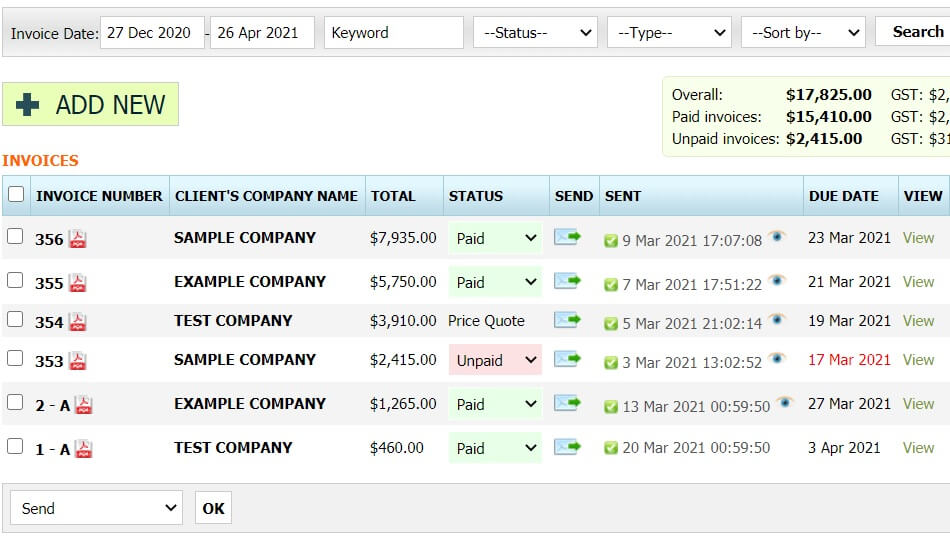Currency on the Invoice in New Zealand
The currency on the invoice will be the unit of currency in which the transaction was executed. The unit of currency is written on all invoices but carries significant importance when it comes to international trade. This is because the home currencies of the buyer and seller may be different. Since it may be unclear if the trade is being executed in the seller’s or buyer’s home currency, defining trade currency in contracts and invoices is essential to avoid any confusion or disputes.

Invoice Currency Example
Commonly used currencies in international trade include but are not limited to, USD, GBP, JPY, EUR, CNY and so forth.
What is the Invoice Currency Code?
A currency code is the three letter code that represents the currency. This code is written on the invoice to represent the functional currency of the invoice. Following are some of the more frequently used currency codes.
| Currency code | Currency name | Country / Region |
| NZD | New Zealand Dollar | New Zealand |
| USD | United States Dollar | United States of America |
| GBP | Great British Pound | United Kingdom |
| CNY | Chinese Yuan Renminbi | China |
| EUR | Euro | Eurozone |
Can Other Currencies be Used on Invoices?
Generally, any currency can be used in international trade, however, it is important that both the seller and buyer should agree on the trade currency. Moreover, it is important to note that the seller will need to ensure that the invoices in foreign currency are not prohibited by their domestic regulations.
Invoice in Foreign Currency
An invoice in foreign currency is used when the business is required to generate and issue an invoice which is in the currency other than the domestic or home country. For example. If you are a New Zealand based exporter and are dispatching goods to the United Kingdom, and you invoice the customer in GBP, then it will be known as a foreign currency invoice.
Next will be a discussion on foreign currency accounting:
Foreign Currency Invoice Accounting
From the seller’s perspective
For accounting purposes, the seller will be required to convert the foreign currency amount to the local or home currency and record it in their books. The conversion rate is the rate taken on the date of the sales invoice.
Furthermore, if the foreign currency receivable remains in the accounting books at the reporting date, the balance is updated in order to reflect the change of the exchange rate at the reporting date. The effect of the change in the foreign accounts receivable is taken to the profit and loss statement.
From the buyer’s perspective
For accounting purposes, the buyer is required to convert the foreign currency payable to their home or local currency. The conversion rate is taken on the date of the purchase invoice.
Further, if the foreign currency payable remains in the accounting books at the reporting date, the balance is updated to reflect the change in exchange rate at the reporting date. The effect of the change in the foreign accounts payable is taken to the profit and loss statement.
Paying Invoices in Foreign Currency
In order to make payments in foreign currency, the buyer must convert the foreign currency amounts into local currency for accounting purposes. This conversion takes place by using the exchange rate on the payment date. In addition to this, any currency conversion charges are taken to the profit and loss statement.
Multi-Currency Invoice
A multi-currency invoice contains two currencies which are, the main currency and the equivalent amount of another currency. This type of invoice is used when the business (seller) engages in cross-border trade with another business (buyer) in another country which has a different operating currency.
By having two currencies on the invoice, it may be complying with a regulatory requirement or may be written to enhance transparency of the transactions or for documentation.
It is prudent to decide the currency that the buyer is required to make payment on, at the time of formation of the contract. This will lessen any confusion that might arise as the result of a multi-currency invoice.
Pattern in Invoicing Currency in Global Trade
There are several factors that can impact the pattern of invoicing currency globally. Some of these factors include, the home currencies of the buyer and seller, currency stability, industry standards, trade agreements and global presence.
Currently the United States Dollar, CNY and Euro dominate the screen of global trade as invoicing currency.
How to Create an Invoice in any Currency
Method 1: Use our simple invoice software
-

- We support all worldwide currencies
- Try It Free
-
Method 2: Download a free invoice template:
Invoicing tools for New Zealand:
